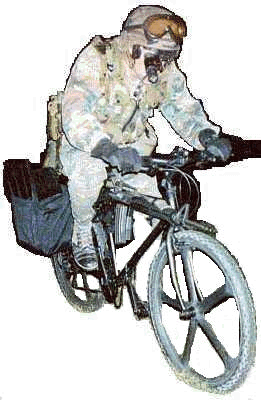
I know General Van Riper having briefed him years ago. However, in past emails, Van Riper and I have clashed because he buys into the bogus USMC superiority myth, but if you stick to details and not personal ego-existentialism he can be persuaded on the facts. He is right on target that RMA is dangerous BS and Rumsfeld must go (see article on bottom of this web page) to discredit and start dismantling the entire push-button firepower anti-physical mentality.
The last article on the bottom of this web page is Happy-Happy, Joy-Joy talk about how now after Soldiers are dying in droves that the Army and marines are finally changing and listening--a day late and a dollar short. This is NOT AOK. Its reactive and not pro-active. Had both outfits not been permeated by egomania these changes proposed by myself and others YEARS BEFORE would have been done long before 9/11, saving thousands of lives. As one example, I proposed the Occluded Eye Gunsight (OEG) collimator gun sight in 1989 long before the USMC "suddenly" in 2004 discovered their iron sight aiming was inadequate at night and the same company's Advanced Combat Optical Gunsight (ACOG) red-dot collimator sight was their salvation. To quote mythical USMC Private Gomer Pyle, "Surprise, Surprise". As another example, I warned that the Humvee truck is a deathtrap in 1989 and the snobs refused then and still refuse now to stop having an underclass drive around mythical "safe", "rear" areas in wheeled trucks and the "light" and "special" feces types in they-think-they-are-sexy dune buggies and Stryker trucks. As soon as the dying stops, with the narcissism still in place, the U.S. military will ditch all the new found armor and equipment and revert back to the garrison BS it longs for: re-enacting the WW2 "From Here to Eternity" culture of mowing lawns and days spent defecating on those with lesser ranks with petty paperwork and back-stabbing. The U.S. military does not look ahead and face realities; all this talk of transformation is a smokescreen to do what they have always wanted to do, but gobble up money from Congress in the processs.
Mike Sparks
Director
1st Tactical Studies Group (Airborne)
BACKGROUND
After nearly freezing to death on a marine reserve exercise in 1982, I began to look for and design better field living/load bearing equipment and then advocating these and field expedient modifications in Marine Corps Gazette and other professional magazines as well as through "official" channels. This caught the attention of maneuver warfare reformer, Bill Lind who advocates an inspired light infantry that can move fast on its feet. In 1989, I was at Quantico as a young LT and Bill arranged for me to brief General Van Riper on how a holistic system could solve the Soldier's load problem and get 4-7 mph mobility. After showing Van Riper the prototypes, marine reserve buddy SGT Ron Schmitt and I had made of a load bearing vest with mesh, drink-on-the-move system, jacket that became a sleeping bag etc. he had me put on a presentation for the entire combat developments staff at MCCDC! This was one of the rare times a blind-obedience, narcissistic bureaucracy ever welcomed improvements to actually do what its supposed to do; and it was only because an inspired person with enough rank (General Van Riper) was in power to insist on it to over-ride the cultural corruption.
PICS OF THE LOADMASTER EARLY HOLISTIC LOAD BEARING SYSTEM VEST (1988)
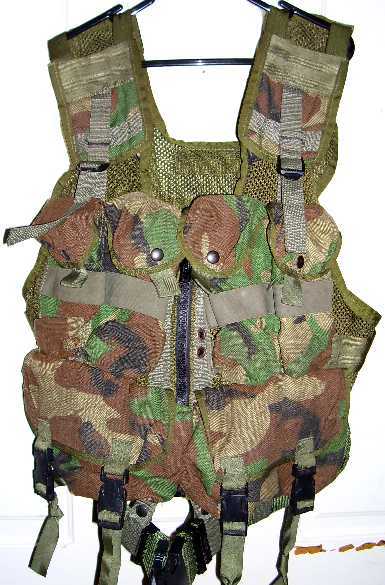
FEATURES:
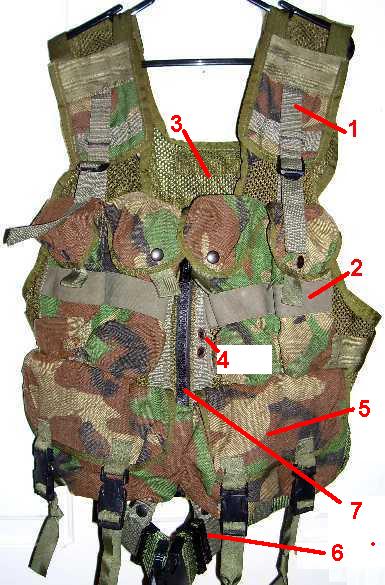
1. Adjustable shoulder strap lengths
2. Elastic on 4 outer pouches to keep 8 x 30-round 5.56mm magazines tight
3. Mesh construction for cooling
4. Eyelets to hold flashlight lanyard
5. Multi-Use Utility Pouch (2)
6. Pistol belt interface
7. Zippered front closure
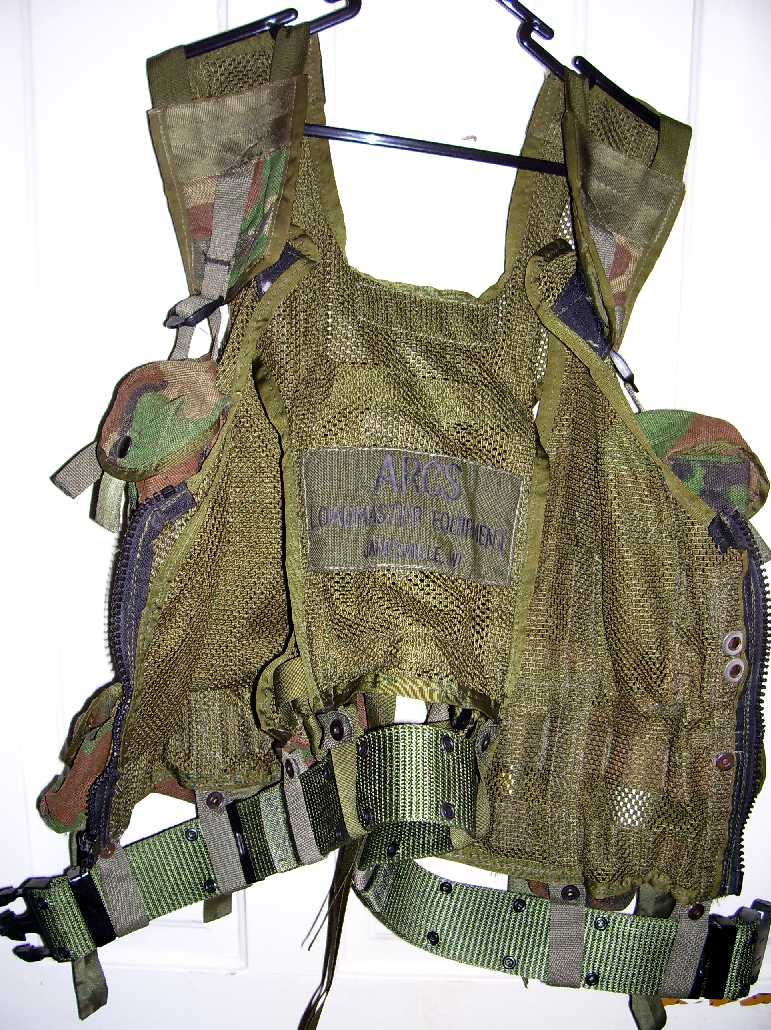
FEATURES:
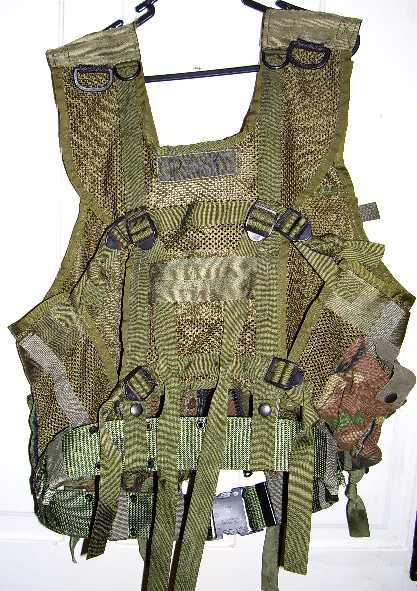
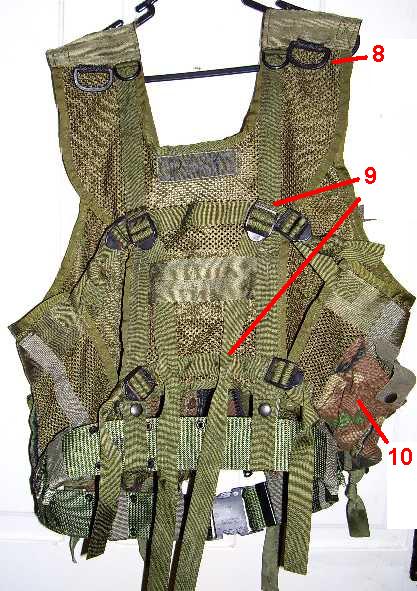
8. "D" rings to clip day packs to
9. Buckle and straps to secure a sleeping bag or bed roll or buttpack top
10. M18 Smoke grenade pouch
MAGAZINE POUCHES
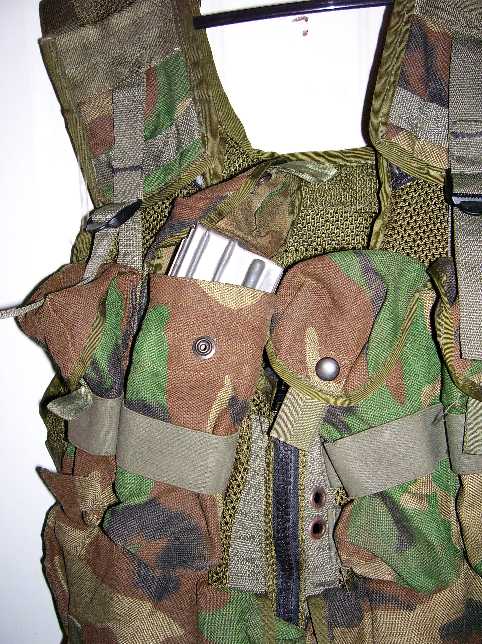
Retired USMC Colonel Robert Young gave us the idea to double-stack magazines to act as defacto hard body armor since in Vietnam one of his men's life was saved when an 7.62mm x 39mm AKM bullet hit a bandolier he was wearing holding two 20-round M16 magazines, stopping the bullet.
MULTI-PURPOSE UTILITY POUCHES with "Dump & Go" Capability
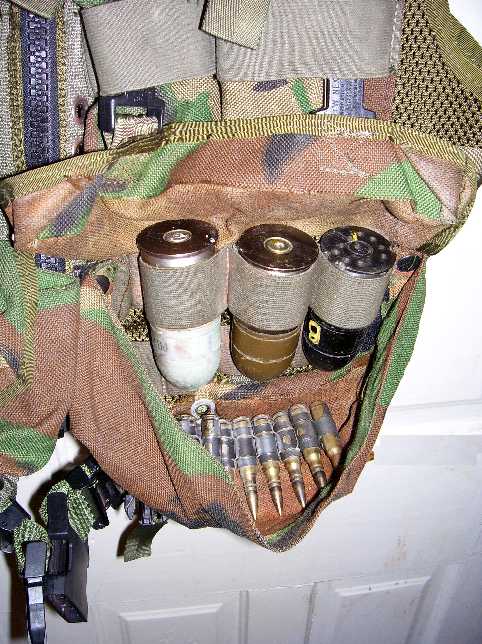
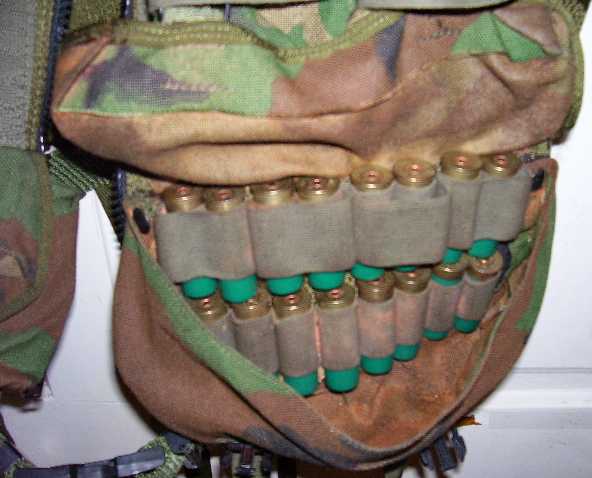
Our goal was an ETLBV that would also carry 12 gauge shotgun shells for those firing them through Mossberg 590s in Marine Security Force Battalions (MCSF) that I had a chance to attend their shooting school as an officer candidate in 1988 thanks to the founder, Colonel Robert Young. Colonel Young also taught me to look at old gear and practices that would also have aspects we could use today and not discount them just because the technology of the time wasn't there to fully exploit them. So both of the Loadmaster ETLBV multi-purpose utility pouches have elastic loops for a total of 32 x 12 gauge shotgun shells.
Another goal was to in the same pouch, have elastic to hold 40mm grenades for the rifleman-grenadiers (see photo above)
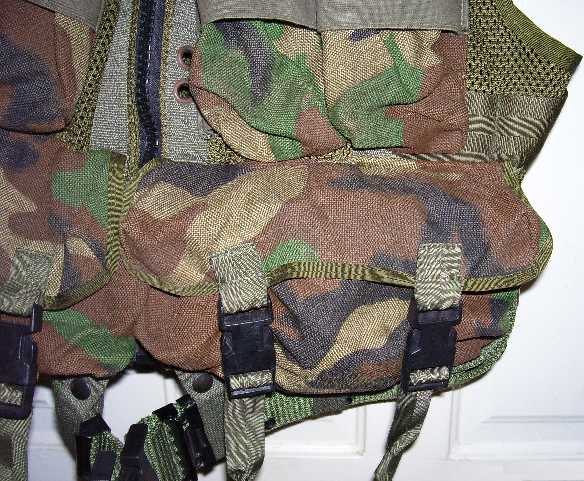
Lastly, we wanted an outer pouch large enough to hold a 200 round belt of 5.56mm for the M249 LMG or 100 rounds of belted 7.62mm x 51mm NATO for the M60 MMG. Ron designed a clever break-open velcro & snap capability to dump the machine gun belts into your hands if needed in a hurry.
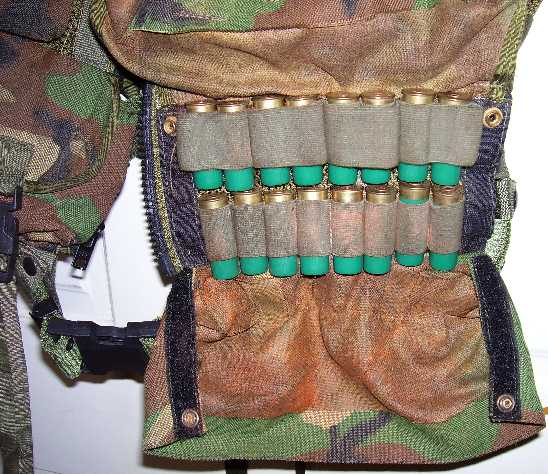
The Van Riper initiative is what started the USMC effort to not just take what the Army at Natick Labs came up with; but to also look to their own solutions, realizing that despite the typical USMC suck-it-up-and-drive-on-lemming-denial-of-there-being-a-problem, the Soldier's Load problem COULD be solved. We showed them it was possible and the rest is history still in the making.
NOTES
Salt Lake TribuneFEEDBACK!
April 28, 2006War Game Exposed Rumsfeld's Incompetence
By Joe Galloway
WASHINGTON - Of those generals who have stepped forward to criticize Defense Secretary Donald H. Rumsfeld and his conduct of the Iraq war, none has pointed out the mistakes of a man who admits no error with more specificity than retired marine Lt. Gen. Paul Van Riper.
Van Riper is widely respected as a military thinker who emerged from combat in Vietnam determined to help get to the bottom of what went wrong there and why and how it should be fixed.
Van Riper, who commanded both the Marine War College at Quantico, Va., and the prestigious National War College in Washington before retiring in 1997, told an interviewer in October 2004 that the military got the lessons all wrong after World War II and that mistake resulted in two disasters - Korea and Vietnam.
"My great fear is we're off to something very similar to what happened after World War II, that is getting it completely wrong again," the general said of the course in Iraq.
The general made it clear he is no anti-war crusader. "We have to stay," he said of Iraq this week. "We have to finish it, but let's do it right."
Van Riper told Knight Ridder that in looking at Rumsfeld's leadership he found three particular areas of inability and incompetence.
First, he said, if any battalion commander under him had created so "poor a climate of leadership" and the "bullying" that goes on in the Pentagon under Rumsfeld, he would order an investigation and relieve that commander.
"Even more than that I focus on (his) incompetence when it comes to preparing American military forces for the future," Van Riper said. "His idea of transformation turns on empty buzz words. There's none of the scholarship and doctrinal examination that has to go on before you begin changing the force."
Third, he said, under Rumsfeld there's been no oversight of military acquisition.
"Mr. Rumsfeld has failed 360 degrees in the job. He is incompetent," Van Riper concluded. "Any military man who made the mistakes he has made, tactically and strategically, would be relieved on the spot."
One event that shocked Van Riper occurred in 2002, when he was asked, as he had been before, to play the commander of an enemy Red Force in a huge, $250 million three-week war game titled Millennium Challenge 2002. It was widely advertised as the best kind of such exercises - a free-play unscripted test of some of the Pentagon's and Rumsfeld's fondest ideas and theories.
Though fictional names were applied, it involved a crisis moving toward war in the Persian Gulf and in actuality was a barely veiled test of an invasion of Iran.
In the computer-controlled game, a flotilla of Navy warships and marine amphibious warfare ships steamed into the Persian Gulf for what Van Riper assumed would be a pre-emptive strike against the country he was defending.
Van Riper resolved to strike first and unconventionally using fast patrol boats and converted pleasure boats fitted with ship-to-ship missiles as well as first generation shore-launched anti-ship cruise missiles. He packed small boats and small propeller aircraft with explosives for one mass wave of suicide attacks against the Blue fleet. Last, the general shut down all radio traffic and sent commands by motorcycle messengers, beyond the reach of the code-breakers.
At the appointed hour he sent hundreds of missiles screaming into the fleet, and dozens of kamikaze boats and planes plunging into the Navy ships in a simultaneous sneak attack that overwhelmed the Navy's much-vaunted defenses based on its Aegis cruisers and their radar-controlled Gatling guns.
When the figurative smoke cleared it was found that the Red Forces had sunk 16 Navy ships, including an aircraft carrier. Thousands of marines and sailors were dead.
The referees stopped the game, which is normal when a victory is won so early. Van Riper assumed that the Blue Force would draw new, better plans and the free play war games would resume.
Instead, he learned that the war game was now following a script drafted to ensure a Blue Force victory: He was ordered to turn on all his anti-aircraft radar so it could be destroyed and he was told his forces would not be allowed to shoot down any of the aircraft bringing Blue Force troops ashore.
The Pentagon has never explained. It classified Van Riper's 21-page report criticizing the results and conduct of the rest of the exercise, along with the report of another DOD observer. Pentagon officials have not released Joint Forces Command's own report on the exercise.
Van Riper walked out and didn't come back. He was furious that the war game had turned from an honest, open free play test of America's war-fighting capabilities into a rigidly controlled and scripted exercise meant to end in an overwhelming American victory.
Joe Galloway is the senior military correspondent for Knight Ridder.
National Journal
May 6, 2006Issues & Ideas
The M-16 Soldiers On
By Sydney J. Freedberg Jr.
Since World War II, the American war machine has excelled at high technology. Today it boasts stealth fighters, cruise missiles, and 60-ton tanks that can shrug off cannon shells. But in the narrow alleys and dark rooms where no machine can go, the U.S. military still relies on young men with rifles, the same centuries-old "weapons system" used by its less formidable adversaries. And since 1945, 80 percent of Americans killed in action have been infantry.
"The money's gone into the big platforms, like fighters and ships," said retired Marine Lt. Gen. Paul Van Riper. "But wait a minute: This is not our Achilles' heel. Our Achilles' heel is infantry casualties. It's changing, but there's this World War II mentality -- the dumb grunts, you give them a rifle, a pair of boots, and a bayonet. We haven't put the money into infantry equipment until quite recently."
Since 2003, items such as body armor, telescopic gun sights, and handheld radios that were once reserved for elite units have become commonplace for individual Soldiers. (See NJ, 4/22/06, p. 32.) But amid all of the changes in the infantry, one thing remains, remarkably, the same: the weapons they carry. The heaviest portable weapons, the M-240 and M-249 light machine guns, entered service in the 1980s. The standard M-16 rifle has been in use since 1964.
"We have the same weapons in 2006 that were grossly inadequate in Vietnam," fumed retired Army Maj. Gen. Robert Scales, who won a Silver Star there in 1969. "Meanwhile, we've been through three generations of fighter planes. There are many, many weapons on the market right now better than the M-16. Why don't we just buy the dang things?"
The M-16 is one of the most bitterly debated firearms in U.S. history. Although the first M-16s misfired regularly in muddy, humid Vietnam, those maintenance problems were largely fixed by later models and better training. But since the 1960s, an intractable and emotional argument has raged over the rifle's relatively small-caliber bullet: just 5.56 millimeters in diameter, compared with the 7.62 standard of its predecessor, the M-14, and the world's most common rifle, the Russian AK-47.
"In every war we've fought using this thing, we've had people complain about the lethality," said retired marine Maj. Anthony Milavic. A Vietnam veteran who became a small-arms activist, Milavic has accumulated report after report of enemies surviving multiple hits from American M-16s, from Ia Drang in 1965 ("Even after being hit several times in the chest, many continued firing and moving for several more steps ... ") to Ramadi in 2003 ("An insurgent was struck in the torso by [seven] rounds.... He continued to fire his AK-47 and mortally wounded Master Sgt. Kevin N. Morehead [and] Sgt. 1st Class William M. Bennett").
"It's primarily anecdotal," Maj. Glenn Dean, chief of small arms for the Army's Directorate of Combat Development at Fort Benning, Ga., says of such reports. "Soldiers have survived wounds by 7.62 rifles, too. You only get an instantaneous kill if you hit the brain."
The Army's Picatinny Arsenal in New Jersey is conducting its most extensive tests of different bullets since 1990, when an M-16 replacement program called the Advanced Combat Rifle was canceled. Milavic says that an interim report revealed that the Army's own testers found the 5.56 to be far inferior to larger calibers. The military's experts reply that they are hardly finished with their research -- and that most of their data so far are only on alternative forms of the 5.56, which has been redesigned since Vietnam.
"We have conducted an initial study on the 5.56, and from there we are going to conduct additional analysis to determine if other calibers are better," said Col. Robert Radcliffe, director of combat development at Fort Benning. "Clearly, bigger is going to have more destructive power -- but there are limits to what Soldiers can carry. It's all about balance."
The primary argument for the 5.56 round, in the 1960s and today, is weight: the lighter the ammunition, the more one man can carry. And quantity matters because most shots fired in the heat of battle miss: Some studies estimate that an average of 50,000 rounds are fired for every casualty.
Since World War I, in fact, most rifle fire has been covering fire, aimed only at keeping the enemy's head down, while heavy weapons such as machine guns, mortars, and howitzers do most of the killing. But in Iraq, concern for civilian casualties has driven U.S. forces away from artillery barrages and "suppressive fire" and toward training infantry riflemen to use sophisticated scopes once reserved for snipers. Interestingly, both snipers and squad marksmen often prefer weapons with the same 7.62 caliber as the old M-14.
The military is testing a radically new weapon meant to combine a sniper's accuracy with explosive power: the XM-25, a rifle-like launcher for 25-millimeter mini-grenades. A built-in laser range finder feeds precise targeting data into each shell's computerized fuse, priming it to detonate not on impact but in midair -- in theory, just over the heads of enemy troops sheltered from regular rifles in trenches or behind walls. It would be especially suited for fighting guerrillas in cities, as in Iraq. But on any battlefield, the "air bursting" technology would represent the biggest innovation in infantry weapons since the machine guns of the First World War.
"We have this great technology that's out there; it's not like it's in the lab," said Lt. Col. Kevin Stoddard, a product manager at Picatinny. But Fort Benning -- whose Directorate of Combat Development must officially certify that a new technology is militarily necessary before it can be bought in quantity for the troops -- hasn't given the green light for a new infantry weapon.
The stumbling block, said Dean, the small-arms chief, is the weight of both the weapons themselves and their ammunition. Even small grenades are much heavier than bullets. And unlike current grenade launchers -- shorter-range and less accurate than the air bursters, but compact enough to clip onto a rifle barrel -- the XM-25 is still so big that an infantryman would have to carry it instead of a rifle, effectively disarming him at ranges too close for explosive shells. Research to make the XM-25 lighter continues, but it is expected to remain a specialist's weapon, and not a replacement for the M-16.
Picatinny was working on an M-16 replacement, the XM-8 -- based on a 5.56-caliber rifle made by Germany's Heckler and Koch -- but that project has been suspended indefinitely. "With a fixed number of dollars to spend, it wasn't a big enough return on investment," Dean said. Instead, the military is focusing limited funding on better gun sights and lighter components for existing weapons.
So the trend is toward less bulk, not more power. Troops in Iraq report that their favored weapon is the M-4, a cut-down version of the M-16 whose shorter barrel makes it less accurate at long range but easier to use in close quarters, such as fighting inside houses or from moving vehicles.
For the long run, the Army is studying advanced polymers for gun components and cartridge cases. An experimental "plastic" M-249, with 600 bullets, weighs half as much as the metal ones used today. But the necessary testing, let alone retooling of factories, Dean said, puts any large-scale fielding of such weapons "10 years out" -- around the 50th anniversary of the M-16.
What's in a Weapon?
The U.S. has used the same rifle for more than 40 years, the M-16 -- upgraded several times but still often criticized as underpowered next to its bulkier rival, the AK-47, used by insurgents from Vietnam to Iraq. High-tech replacements like the XM-25 show promise, but their complexity and bulk remain a barrier.
Comparing calibers -- The bigger the projectile, the more damage it can do -- but the less ammunition troops can carry.
M-16: The standard U.S. rifle since 1964, designed for portability, not power. Length (inches): 39.6, Unloaded Weight (lbs): 7.5, Magazine (rounds): 30, Range (meters): 600
AK-47: The world's most common rifle, a rugged Russian design. Length (inches): 34.2, Unloaded Weight (lbs): 9.5, Magazine (rounds): 30, Range (meters): 400
XM-25: Experimental weapon that fires high-tech, and heavy, explosive shells. Length (inches): "less than 30", Unloaded Weight (lbs): 14, Magazine (rounds): 4, Range (meters): 500
SOURCE: U.S. Army
________________________________
www.nationaljournal.com/about/njweekly
National Journal
April 22, 2006The Military
The Ultimate Smart Weapon
By Sydney J. Freedberg Jr.
SAND HILL TRAINING AREA, FORT BENNING, Ga. -- The Army drill sergeant rebuked a group of recruits who had fired their rifles too hastily in a mock ambush. "You know we've got civilians on the battlefield," said 1st Sgt. Dennis Williams. "Just because your buddy fires, doesn't mean you fire." You've got to be aware of exactly what you're shooting at, Williams told the Soldiers. Be aware of what you're not shooting at, too; don't focus on the first target that pops up and forget your flank. "Everybody wants to kill that same guy, but those guys over there," he said gesturing to the side, "would've wiped us all out!" Be aware even when the battle is won and you're searching the prisoners for weapons, insignia, family photos, Williams said. "You've got to be checking everything. Every piece of information you find is important."
Williams wasn't shouting. He did not even raise his voice. He just shook his head and said, exasperated, "You all are in week 11."
The two dozen recruits sitting on the concrete floor knew exactly how serious their situation was. Today's ambushers were pop-up paper targets, the prisoners were mannequins, the road unmined. But soon the targets, bystanders, and bombs would be live. In less than a month, these recruits would graduate from their 14-week course at Fort Benning's Infantry Training Brigade and join regular units headed, sooner or later, to Iraq.
Staff Sgt. Robert Col--n, another instructor at Benning and, like Williams, a veteran of Iraq, tells his recruits that they have to get it right, because the unpredictability of warfare in Iraq might suddenly put them in the lead.
"Over there, I've had privates save my life. I've saved my privates' lives. It's just the way it goes," Col--n said. "Get rid of the whole 'I'm just a private' mentality, because it just doesn't protect you from bullets," he said. "In the battle of Falluja, we lost our battalion sergeant major, our Alpha Company commander. At any given time, a private's going to have to step up to be a leader."
War is driving change across the U.S. Army and marine corps, and nowhere more so than in the oldest military specialty of all, the often-neglected foot Soldiers of the infantry.
While air forces evolved from biplanes to stealth bombers, and navies from gun turrets to cruise missiles, the "poor bloody infantry" stayed mostly the same from the First World War to the Persian Gulf War: helmets, grenades, rifles, a few light machine guns, and leather boots. The decades added awkward flak vests that could sometimes stop shrapnel, but not bullets.
Today, however, the Soldiers at Fort Benning are visibly different from their predecessors of just three years ago. They wear Kevlar jackets reinforced with rigid breast and back plates, 16 pounds per man, the first mass-produced bulletproof armor in history and all but unknown in the U.S. military before the invasion of Iraq. The Soldiers carry rifles with sophisticated optical sights, tools that, before the insurgency, were reserved for snipers and commandos. They practice treating casualties with a new first-aid kit -- tourniquet, gloves, and an Israeli-developed pressure dressing -- that was derived from last year's battlefield lessons.
And these are just the tools, the visible surfaces of far more fundamental changes in how human beings are being taught to fight. "When I went through basic training, it was about four hours of 'here's a pressure dressing,' " recalled Sgt. 1st Class Michael Clay, a Benning instructor who first fought Iraqis in 1991. "Now we have two days dedicated to that alone." And trainers reinforce the first-aid skills, working casualty drills into other exercises, to make sure Soldiers know how to quickly and efficiently treat a wounded comrade.
Those exercises are more demanding than they used to be. Privates practice leading squads and teams of fellow recruits -- normally an experienced sergeant's job -- and under close supervision, they devise and execute their own plans for practice missions. They move swiftly from sterile shooting ranges to live-fire drills like the one Sgt. Williams took his recruits through, a jolting truck ride down dirt roads, with targets popping up on either side. It was a simulated ambush of a simulated convoy -- to which the recruits responded with bursts of real bullets, fired first from their lurching, moving vehicles and then as they leapt out to counterattack on foot.
"I didn't do half of this," said Lt. Col. Ricardo Mitchell after he and the recruits finished the exercise. Mitchell did his basic training in the peacetime Army of the 1980s. Today, as commander of one of Benning's training battalions, he said, "We are teaching things to privates comparable to what, five or six years ago, we were asking lieutenants to do."
Soldier as System
A revolution is under way in the American infantry. After 9/11, "the box opened up," said Staff Sgt. Timothy Howell, a Benning instructor. In the 1990s, the Army's mantra was,
" 'The book says -- the book says,' " he recalled. "Now it's, 'What's your experience in Iraq?' " Survey teams went to Baghdad shortly after the city fell in 2003 to get feedback from troops on their equipment. "I'm still amazed at all the changes that have been made -- body armor, knee pads, helmet chin straps, even these boots," Howell said, "because a Soldier said, 'This would be better,' and somebody listened. Now the Army is actually listening."
The institutional Army still struggles, however, to treat foot Soldiers with the same focused seriousness that it treats tanks. "It's difficult because it requires us to make changes in how we fund items," said Col. Robert Radcliffe, director of Combat Developments at Fort Benning's Infantry Center. A tank is designed, tested, and fielded as a package: "It's got a weapon, it's got communications, it's got armor. But we've never treated a Soldier as a system," Radcliffe said. "We've got a rifle that's got its own funding line and a radio that's got its own funding line. As we develop equipment, we give it to the Soldier, never paying much attention to how these pieces of equipment interact."
The Army has developed more than 300 individual items that a Soldier could potentially wear or carry (not counting heavy equipment). Many are incompatible. Until a 2004 redesign, the standard helmet snagged on the back plate of the new body armor when a Soldier looked up sharply. Fort Benning now teaches recruits a new way to hold their rifles because the rigid chest plate restricts their arm movement. The standard night-vision sight can unbalance the helmet so much that it makes some Soldiers' heads bob. A squad has to haul nine different kinds of batteries. All told, the average infantryman carries 65 to 90 pounds of equipment into combat.
This summer, the Army will issue the first set of gear designed as an integrated ensemble, called "Land Warrior," on a trial basis to more than 400 troops at Fort Lewis, Wash. The product of a difficult decade-long development process, Land Warrior incorporates not only body armor, radios, and night vision but also a tactical computer network -- all running off compatible batteries. If the Soldiers like it, they will deploy with it to Iraq.
But new technology and training can help only so much. Human flesh remains terribly fragile. In an era of stealth jets, cruise missiles, and satellite-guided bombs, the world's high-tech superpower still depends on infantrymen willing to walk into harm's way.
Why Infantry, Anyway?
Out of 1.4 million military personnel on active duty, according to retired Maj. Gen. Robert Scales, who was an Army War College commandant, "at last count, there were 65,000 infantrymen in the Army and the marine Corps, combined. They wouldn't fill [Washington's] FedEx stadium! With the exception of Kosovo" -- a campaign waged entirely by air strikes -- "in every war this nation has fought, we have run out of infantry. What we've had was airpower and artillery that was able, to some degree, to make up for the deficiencies of the infantry with firepower. So what have our enemies done lately? They've found ways to avoid firepower."
The insurgency began in Iraq when the ragtag guerrillas of the Saddam Fedayeen survived a U.S. onslaught that destroyed Saddam Hussein's best-armored tanks. Bombarding the cities where the Fedayeen holed up would have caused horrific civilian casualties -- without necessarily defeating the Fedayeen, as history shows. Unrestricted firepower flattened countless buildings in World War II, such as the hilltop monastery of Monte Cassino, but the defending infantry didn't just survive, the Soldiers turned the rubble into fortresses -- from which only other infantry units could dig them out. Nor are today's smart weapons the whole answer: Saddam evaded missile strikes only to be hauled out of his spider hole by a foot Soldier. M1 tanks and M2 armored transports built for the plains of Cold War Europe have proven to be effective city fighters, spearheading assaults into Baghdad and Falluja. But someone still has to walk alongside to keep insurgents from sneaking up in the juggernauts' blind spots. And no tank or spy plane can search the inside of a house.
So in Iraq, technically trained troops such as artillerymen and engineers often park their heavy equipment and pull double duty as infantrymen. And with no demarcated front line in Iraq, mechanics and supply clerks and other rear-area troops end up defending their base areas and convoys.
"It didn't matter what your military specialty was," said Staff Sgt. Howell. "If you were a truck driver, you were a truck driver as long as you were behind the wheel, but as soon as that truck stopped, you were an 11-Bravo" -- the Army code for combat infantry.
Howell is a drill sergeant in Fort Benning's Basic Combat Training Brigade, which is intended to give every new private core combat skills. "We've got a radiology technician," Howell said, gesturing at one of his recruits. "He's still digging holes and doing the battle drills." Just like the future full-time infantrymen in the more intensive Infantry Training Brigade, the future support troops in the Basic Combat Training Brigade carry their rifles all day and take turns guarding them at night, Howell said, "just like they will in Iraq." And like all military personnel who venture off base in Iraq, they wear full body armor.
"When I came into the Army," Howell said, "we had these big, clunky flak vests. You knew they weren't going to stop anything." He rounded on one of his recruits who was wearing, like all the others, 16 pounds of Kevlar and ceramic in the unseasonable Georgia heat: "You love that body armor!"
"Uh -- yes, sir!" replied the private.
"Are you lying, Soldier?"
"A little bit, sir."
Howell and the other drill sergeants chuckled knowingly.
The Armor Dilemma
In early 2003, the Army and marines began fielding thousands of sets of "small-arms protective inserts," a bulletproof ceramic plate that slips into the standard flak jacket. "The first time I had the SAPI plates was when they were issued in Kuwait" just before the invasion of Iraq, recalled marine corps Maj. Patrick Cashman. "We knew that pocket was in the vest for something: Maps? Toilet paper?"
For the first time in 400 years, since the perfection of the musket, the technology of protecting the infantryman had caught up, almost, to the technology of killing him. World War II troops wore no armor except a steel "pot" helmet. The Vietnam era produced flak jackets that could stop some shrapnel, but not bullets. But with SAPI, said Arthur Durante, a developer of infantry manuals at Fort Benning, "I've got photographs of guys holding the flattened bullet that hit them in the chest: It knocked them down, but they got up and shot the guy that shot them." (See photo, p. 38.)
So while troops in Vietnam routinely ditched their sweltering flak jackets, troops in Iraq do not. "Once, we ended up pushing 5 kilometers or so [on foot], north of Haditha," said Capt. Christopher Conner, who now teaches new marine lieutenants at The Basic School in Quantico, Va. "It was probably 110 degrees. Not one single time did one single marine break the seal on his flak jacket."
Army Capt. Eric Hillerson, an instructor at Fort Benning, agreed. "We saw that it did work," he said. "We didn't go out the [base] gate without our helmets and vests on. It's hot and heavy, but the protection is worth it."
Body armor has kept the G.I. death toll down in Iraq. But with the military issuing more add-on armor to cover the gaps where troops get wounded -- thighs, groin, shoulders, beneath the armpit where the flak jacket fastens -- the weight of the full kit has doubled, from 16 to 33 pounds. (See graphic, opposite page.)
"The newer SAPI plates, if they're optional, a lot of guys won't wear them, because there's so much weight," said Maj. Brett Clark, a marine corps veteran of Falluja now on loan to Fort Benning as an instructor in the Army infantry captain's course. "At what point do we stop piling on that weight? Is the armor going to slow you down enough that you're easier to hit?"
Equipment officials are racking their brains. "The armor is one of those places where a hard choice had to be made," said Maj. Cashman, now the infantry capabilities officer for the Marine Corps Combat Development Command at Quantico. "We are at the technological limit for ceramic plates right now."
At the Soldier Center in Natick, Mass., which serves both the Army and marines, researchers are working on next-generation armor. Today's ceramic-reinforced flak jacket fits snug and hot over the body, with its weight all on the shoulders, like medieval chainmail. Natick's new armor is supported by a rigid frame that distributes the weight and leaves room for a cool, breathable fabric underneath, like a Renaissance cavalier's suit of steel plate. Designers are transforming today's optional add-ons that cover the shoulders, neck, and thighs into a working ensemble. Researchers are building electronic items, issued today as separate gear, into the helmet and the body armor, whose frame picks up radio signals like an antenna.
"We're putting that prototype together," said Natick Director Philip Brandler, "and we'll be out in the field next year to evaluate it." In three years, he added, experimental polymers now in the lab could provide current levels of protection for half the weight -- or could furnish more protection at the current weight. "We have a very responsive enemy," Brandler said, "and as we provide certain levels of protection, they up the threat."
No amount of armor can make a man into a walking tank. The infantryman's first line of defense is his eyes, his ears, and his own quick thinking -- which intense training, and select technology, can sharpen.
Precision-Guided Humans
When he went through basic training just 10 years ago, recalled Staff Sgt. Howell, the drill sergeants' mantra was, "Put your head down and walk!" Now an Iraq veteran and drill sergeant himself, Howell said, "the No. 1 thing I stress for these Soldiers is, you have to look around. You have to know what's normal. That way you can know what's abnormal. So if you come down the road one day and there's no kids playing where there used to be kids, you get that feeling in your stomach and tell someone, before the attack."
Today, "Know the normal" is the infantryman's mantra. "He needs to look for the absence of the normal, as opposed to the presence of the abnormal," said Maj. Clark, the marine officer, unconsciously echoing the Army sergeant. "Children on the street -- trash on the street -- the slightest change. He is himself an intelligence-gathering device." Instructors at Benning now often leave soda cans, sandbags, or other objects out of place in the barracks to test how quickly the recruits notice.
While awareness begins with training, technology can augment it. Some of the American infantryman's most powerful tools are the least obvious. Look past their bulky body armor to their handheld radios and headsets, the scopes on their rifles, and the ungainly black attachments on their helmets -- "night-optical devices," a little revolution in themselves.
"We had 'starlight scopes' in Vietnam," recalled retired Maj. Gen. Waldo Freeman, "but they were so maintenance-intensive that a typical company" -- 50 to 135 men, depending on casualties -- "would have maybe three that worked." The foot-long, telescope-like devices were too bulky to use on the move, in any case, he said: "When we actually had to move after dark, you'd walk all night and get maybe 3 kilometers." So while Vietnamese light infantry, like the Chinese in Korea and the Japanese in the Pacific, would slip through U.S. defenses to launch bold night attacks, the Americans would hunker down and wait for daylight to restore their firepower and mobility.
Today, it is U.S. troops who run convoys and launch attacks under cover of darkness. "We did the majority of our missions in limited visibility," said Capt. Scott Thomas, an Iraq veteran now teaching young officers at Fort Benning. "We had the ability to see at night when the enemy couldn't."
Maj. Pete Farnum, now an instructor at the Marine Corps School of Infantry at Camp Pendleton, Calif., echoed Thomas. "We went into Falluja at night and got a foothold in the city almost without a shot being fired," he said. "Then when the sun came up, all hell broke lose. But night was pretty quiet: The enemy knew we had the optics, so they'd go to sleep and the next morning pick up their rocket-propelled grenades."
The difference, however, is not just technology, emphasized Lt. Col. Chris Carolan of Quantico's experimental Marine Corps Warfighting Lab. "There was a concerted effort after Vietnam to get us better at fighting at night," he said. "You have to know how to operate at night without the aid of night-vision devices before you can slap 'em on. That's training."
"We Know Who We Kill"
Well-trained troops can "out-see" the enemy by day as well. Soldiers and marines still carry an updated version of the M-16 rifle introduced in Vietnam -- but the military has actually suspended work on a replacement weapon, the XM-8, to devote funds to what it considers the real revolution: adding gun sights to existing rifles. After a cease-fire cut short that first assault on Falluja in April 2004, Maj. Farnum recalled, "one of the first things that the insurgents requested was that the marine corps pull out all the snipers from Falluja. They thought we had snipers everywhere. But it was regular marines, trained in combat marksmanship, with the advanced combat optics."
"That's not a new technology," said Maj. Cashman of the Marine Corps Combat Development Command. "We didn't invent the telescopic sight." But after a trial fielding of a thousand ACOGs -- Advanced Combat Optic Gunsights -- to Iraq in 2004, he said, "word got back: These were war-winners, and we've given [them] to every single marine infantryman."
Unlike the marine corps, the Army restricts the telescopic sights to one designated marksman in each squad. Regular Soldiers -- including an ever-larger majority of recruits at Fort Benning -- instead get a "close combat optic," a sighting device that has no magnification but is suitable for short-range street fights.
"Five years ago," said Maj. Glenn Dean, chief of small arms for the Directorate of Combat Developments at Fort Benning, "we were an 'iron sight' army," trained to aim just like every rifleman since the 19th century: Squint and shoot, carefully aligning the post at the front of the barrel with the notch at the back (the "iron sights"). Today's optics let troops throw their rifles to their shoulders, both eyes open, for a quick, accurate shot on a fleeting target. Combat battalions which used to have no optical sights, except for those carried by their snipers, now give them to every Soldier.
The new gun sights are not just tools for better shooting: They are also tools for knowing when not to shoot. "The big thing we stressed is, don't fire back unless you have positive identification," said one marine officer. His commander in Iraq would answer complaints about civilian casualties by letting Iraqis look through his telescopic sight: "Every marine has one of these," the commander would say. "We know who we kill."
But better gun sights make no difference to troops who are too scared or enraged to use them. Especially in the first year of the insurgency, too many American patrols and convoys responded to roadside bombs or snipers by laying down "suppressive fire" in all directions -- what cynical veterans call the "death blossom." And in crowded cities, even a well-aimed shot can kill a civilian or a comrade.
"When you train, you shoot a target, and you don't ever really think about what's behind that target," said drill sergeant Col--n. "But bullets actually go through things. They go through houses, and they go through people. That was a hard lesson learned in the first couple of weeks in Iraq, and that's one of the things I emphasize heavily now that I never used to emphasize before."
At Fort Benning, Army recruits routinely train with targets depicting men, women, and children -- and are scored not just on their hits but also on what they do not shoot. "If you're going to knock at 90 houses and enter without any type of enemy action, you can't expect that the 91st house isn't going to be the one," said Staff Sgt. Brad Watson, an Iraq veteran and Fort Benning drill sergeant, as recruits rushed past him, rifles and optics ready, into a mock village. "And it's hard to tell infantry Soldiers when not to flip on that switch, because they have to go in with a certain amount of aggression. You have to train them on identifying targets, and it's got to be constant. It's got to start at that individual Soldier."
But it can't stop there. Commanders also need a new awareness of civilians.
Information Warriors
For decades, if military doctrine mentioned civilians at all, it treated them as just one more obstacle on the battlefield. Infantry in Iraq have learned to watch the mood of local civilians -- or their absence -- as the best clue of an impending ambush. And commanders have learned to make better use of both civilian informants and their own foot patrols' firsthand observations.
As a young officer in Fort Benning's infantry captain's course in 2000, recalled Maj. Desmond Bailey, who is now back as an instructor, "I don't think we ever discussed civilian considerations."
In the 1990s, said Lt. Col. Steven Russell, who commanded Bailey in Iraq and now heads the captain's school, civilians were mentioned in Army training only in the context of a peacekeeping mission that would follow a conflict.
When training for actual combat, Bailey said, "we just wished the civilians away." But as a commander in Iraq, Capt. Thomas said, "That was the steepest learning curve: Not having the ability to wish the civilians away and focus on a uniformed enemy. You may spend part of the day on patrol, getting in a direct-fire engagement, but four hours later, you're meeting with a local sheik."
"I tried to ignore them," Bailey admitted. "We were driving through their crops because [insurgents] were ambushing us on the roads. But if you keep ticking them off, they aren't going to give you the information that you need. Until I actually started interacting with the populace, I didn't get that information. And we would not have ended up with Saddam" -- whose spider hole was found in the area that Russell's troops patrolled around Tikrit -- "if we had not utilized the local population."
No spy plane or satellite can talk to local leaders or sense the local mood as it walks down the street. But technology can speed the flow of human intelligence from one human to the next. On one raid, Thomas recalled, he sent each of his squads to hit a different house -- and discovered that the "high-value target" they were looking for was in none of them. An Iraqi told Thomas the target's real location: about 20 minutes away from Thomas, but just a few doors down from one of his scattered squads. "This guy was getting ready to run," Thomas said. So he called his nearest sergeant on the radio and that sergeant's squad was able to hit the house four or five minutes later.
This seems like no big deal until you realize that, until recently, Thomas's sergeant would not have had a radio: The bulky sets were limited to vehicles or to one overburdened operator in a platoon of 40 men. "When I was a platoon leader, we didn't have squad radios," recalled Lt. Col. Russell. "We would see them on occasion, but they were very short range and unreliable. I had to get where I could do hand and arm signals."
Today, compact electronics -- and a military chastened by sergeants buying Motorola walkie-talkies out of their own salaries -- allow each squad of six to 13 troops to carry at least one radio. Personal radios and even hands-free headsets are proliferating.
Before the storming of Falluja, recalled Maj. Clark, "I told my gunnery sergeant we needed to get more radios. We had radios down to the team leader level": one for every four men, the smallest "assault element" that typically makes the first entry into a house while the rest of the squad provides covering fire and reinforcements. Over gunfire and through stone walls, Clark said, "you wouldn't otherwise be able to hear [to coordinate]. Having additional radios saved lives."
Both the marines and the Army have experimented with sophisticated information technology for foot Soldiers. The trial fielding of the Land Warrior kits to Soldiers at Fort Lewis this summer will include not only radio headsets but electronic eyepieces that show troops their own location and that of friendly units on a computer map, updated via a wireless network -- a capability previously limited to vehicles. The Natick Soldier Center's next-generation "Future Force Warrior" will add more sensor displays and sharing of targeting data over the network.
These technologies, however, will require additional hours of training. Retired Army Col. Richard Sinnreich, a frequent participant in Army experiments, said, "It requires a whole different type of training to make the infantryman comfortable using that technology without distracting him. The more we digitize, the more infantry have to become proficient at a whole set of skills besides aiming a rifle and digging a foxhole."
Technology plus training can make infantrymen more effective. Technology without training can get them killed. The situations that Soldiers face on the streets of Iraq, or elsewhere, and the tools they use are getting more complex. But the emerging revolution in American infantry is not making the role of the infantry any less demanding.
"The vast responsibility that is pushed down to the lower levels, the combat power that is pushed down to the lower levels, the larger areas of operation, as well as the technology, requires better trained, tactically savvy, intelligent leaders," said Maj. Clark, looking at his young officer-students a few yards away. "Intelligent grunts: That's almost a contradiction. But it's definitely a thinking man's game."
More Than a Uniform
A Soldier's equipment has changed dramatically since the invasion of Iraq in 2003. Items reserved for elite units even a few years ago, and all but unknown in Vietnam, are now commonplace as the military learns how to hunt guerrillas on foot through crowded cities: truly bulletproof body armor, gun sights with sophisticated optics, and short-range personal radios. But wearing all of this hardware slows Soldiers down, especially in the brutal Iraqi summer, pushing equipment developers to cut weight, not just add gadgets.
Innovations for the combat zone
Vietnam (1965) --First fully automatic "assault rifles" (M-14 and M-16); Flak jackets stop shrapnel, but not bullets
Persian Gulf War (1991) -- Global Positioning System handsets; Kevlar helmets and flak jackets
Future (2010) -- Troop position and targeting data shared via network; Electronics built into helmet; Night-vision devices: flip up and out of the way when not in use; Body armor: stops rifle bullets, but is heavy and hot; Resoled boots: less likely to fall apart than old leather ones; Protective sunglasses: resist shrapnel; Optical gun sight: allows quicker, more accurate shots; Knee and elbow pads: prevent injury in cities when troops 'hit the dirt" on concrete
SOURCES: Program Executive Office Soldier; U.S. Army Natick Soldier Center
MP3 music from "Batman Begins" by Hans Zimmer